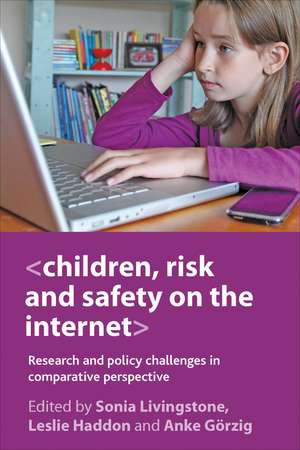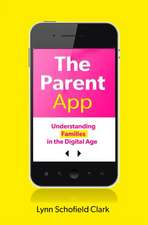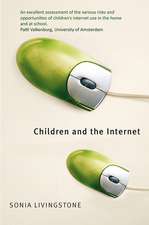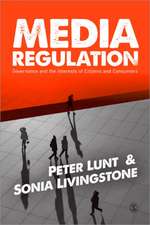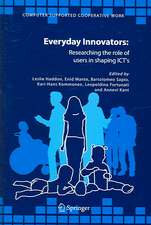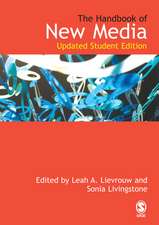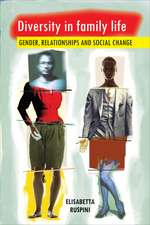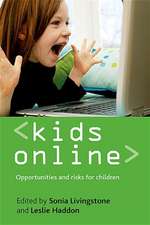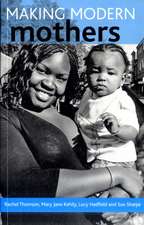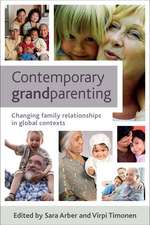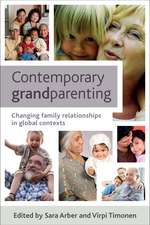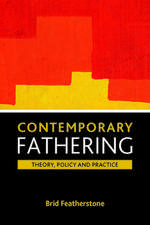Children, Risk and Safety on the Internet: Research and policy challenges in comparative perspective
Editat de Sonia Livingstone, Leslie Haddon, Anke Görzigen Limba Engleză Paperback – 17 iul 2012
| Toate formatele și edițiile | Preț | Express |
|---|---|---|
| Paperback (1) | 337.91 lei 3-5 săpt. | |
| Bristol University Press – 17 iul 2012 | 337.91 lei 3-5 săpt. | |
| Hardback (1) | 785.38 lei 6-8 săpt. | |
| Bristol University Press – 17 iul 2012 | 785.38 lei 6-8 săpt. |
Preț: 337.91 lei
Nou
Puncte Express: 507
Preț estimativ în valută:
64.67€ • 70.22$ • 54.32£
64.67€ • 70.22$ • 54.32£
Carte disponibilă
Livrare economică 01-15 aprilie
Preluare comenzi: 021 569.72.76
Specificații
ISBN-13: 9781847428820
ISBN-10: 1847428827
Pagini: 256
Dimensiuni: 152 x 229 x 20 mm
Greutate: 0.66 kg
Ediția:New.
Editura: Bristol University Press
Colecția Policy Press
ISBN-10: 1847428827
Pagini: 256
Dimensiuni: 152 x 229 x 20 mm
Greutate: 0.66 kg
Ediția:New.
Editura: Bristol University Press
Colecția Policy Press
Recenzii
“The EU Kids Online project is the most theoretically informed and methodologically sophisticated study we have on the issue of risks in the new electronic environment. This book is rich in details and insights that greatly advance our understanding.”
“Children, Risk and Safety on the Internet provides sound data that policy-makers, educators, and parents can use to make judgments around children and the internet and will be a valuable asset for those seeking an informed understanding of online risks.”
Notă biografică
Sonia Livingstone directs the EU Kids online network at the London School of Economics where Leslie Haddon is a senior researcher in the Department of Media and Communications. Together they are coauthors of Kids Online, also published by the Policy Press. Anke Görzig is Research Fellow in Social Statistics at the Anna Freud Centre/University College London and was Survey Research Office for EU Kids Online II.
Cuprins
List of tables and figures
Acknowledgements
Notes on contributors
1. Theoretical framework for children’s internet use
Sonia Livingstone and Leslie Haddon
2. Methodological framework: EU Kids Online project
Anke Görzig
3. Cognitive interviewing and responses to EU Kids Online survey questions
Christine Ogan, Türkan Karakus, Engin Kursun, Kürsat Çagiltay and Duygu Kasikçi
4. Which children are fully online?
Ellen Helsper
5. Varieties of access and use
Giovanna Mascheroni, Maria Francesca Murru and Anke Görzig
6. Online opportunities
Pille Pruulmann-Vengerfeldt and Pille Runnel
7. Digital skills in the context of media literacy
Nathalie Sonck, Els Kuiper and Jos de Haan
8. Between public and private: privacy in social networking sites
Reijo Kupiainen, Annikka Suoninen and Kaarina Nikunen
9. Experimenting with the self online: a risky opportunity
Lucyna Kirwil and Yiannis Laouris
10. Young Europeans’ online environments: a typology of user practices
Uwe Hasebrink
11. Bullying
Claudia Lampert and Verónica Donoso
12. ‘Sexting’: the exchange of sexual messages online among European youth
Sonia Livingstone and Anke Görzig
13. Pornography
Antonis Rovolis and Liza Tsaliki
14. Meeting new contacts online
Monica Barbovschi, Valentina Marinescu, Anca Velicu and Eva Laszlo
15. Excessive internet use among European children
David Šmahel and Lukáš Blinka
16. Coping and resilience: children’s responses to online risks
Sofie Vandoninck, Leen d’Haenens and Katia Segers
17. Agents of mediation and source of safety awareness: a comparative overview
Dominique Pasquier, José Alberto Simões and Elodie Kredens
18. The effectiveness of parental mediation
Maialen Garmendia, Carmelo Garitaonandia, Gemma Martinez and Miguel Ángel Casado
19. Effectiveness of teachers’ and peers’ mediation in supporting opportunities and reducing risks online
Veronika Kalmus, Cecilia von Feilitzen and Andra Siibak
20. Understanding digital inequality: the interplay between parental socialization and children’s development
Ingrid Paus-Hasebrink, Cristina Ponte, Andrea Dürager and Joke Bauwens
21. Similarities and differences across Europe
Bojana Lobe and Kjartan Ólafsson
22. Mobile access: different users, different risks, different consequences?
Gitte Stald and Kjartan Ólafsson
23. Explaining vulnerability to risk and harm
Alfredas Laurinavicius, Rita Žukauskiene and Laura Ustinaviciute
24. Relating online practices, negative experiences and coping strategies
Bence Ságvári and Anna Galácz
25. Towards a general model of determinants of risk and safety
Sonia Livingstone, Uwe Hasebrink and Anke Görzig
26. Policy implications and recommendations: now what?
Brian O’Neill and Elisabeth Staksrud
Appendix: Key variables used in EU Kids Online analyses
Index
Acknowledgements
Notes on contributors
1. Theoretical framework for children’s internet use
Sonia Livingstone and Leslie Haddon
2. Methodological framework: EU Kids Online project
Anke Görzig
3. Cognitive interviewing and responses to EU Kids Online survey questions
Christine Ogan, Türkan Karakus, Engin Kursun, Kürsat Çagiltay and Duygu Kasikçi
4. Which children are fully online?
Ellen Helsper
5. Varieties of access and use
Giovanna Mascheroni, Maria Francesca Murru and Anke Görzig
6. Online opportunities
Pille Pruulmann-Vengerfeldt and Pille Runnel
7. Digital skills in the context of media literacy
Nathalie Sonck, Els Kuiper and Jos de Haan
8. Between public and private: privacy in social networking sites
Reijo Kupiainen, Annikka Suoninen and Kaarina Nikunen
9. Experimenting with the self online: a risky opportunity
Lucyna Kirwil and Yiannis Laouris
10. Young Europeans’ online environments: a typology of user practices
Uwe Hasebrink
11. Bullying
Claudia Lampert and Verónica Donoso
12. ‘Sexting’: the exchange of sexual messages online among European youth
Sonia Livingstone and Anke Görzig
13. Pornography
Antonis Rovolis and Liza Tsaliki
14. Meeting new contacts online
Monica Barbovschi, Valentina Marinescu, Anca Velicu and Eva Laszlo
15. Excessive internet use among European children
David Šmahel and Lukáš Blinka
16. Coping and resilience: children’s responses to online risks
Sofie Vandoninck, Leen d’Haenens and Katia Segers
17. Agents of mediation and source of safety awareness: a comparative overview
Dominique Pasquier, José Alberto Simões and Elodie Kredens
18. The effectiveness of parental mediation
Maialen Garmendia, Carmelo Garitaonandia, Gemma Martinez and Miguel Ángel Casado
19. Effectiveness of teachers’ and peers’ mediation in supporting opportunities and reducing risks online
Veronika Kalmus, Cecilia von Feilitzen and Andra Siibak
20. Understanding digital inequality: the interplay between parental socialization and children’s development
Ingrid Paus-Hasebrink, Cristina Ponte, Andrea Dürager and Joke Bauwens
21. Similarities and differences across Europe
Bojana Lobe and Kjartan Ólafsson
22. Mobile access: different users, different risks, different consequences?
Gitte Stald and Kjartan Ólafsson
23. Explaining vulnerability to risk and harm
Alfredas Laurinavicius, Rita Žukauskiene and Laura Ustinaviciute
24. Relating online practices, negative experiences and coping strategies
Bence Ságvári and Anna Galácz
25. Towards a general model of determinants of risk and safety
Sonia Livingstone, Uwe Hasebrink and Anke Görzig
26. Policy implications and recommendations: now what?
Brian O’Neill and Elisabeth Staksrud
Appendix: Key variables used in EU Kids Online analyses
Index
